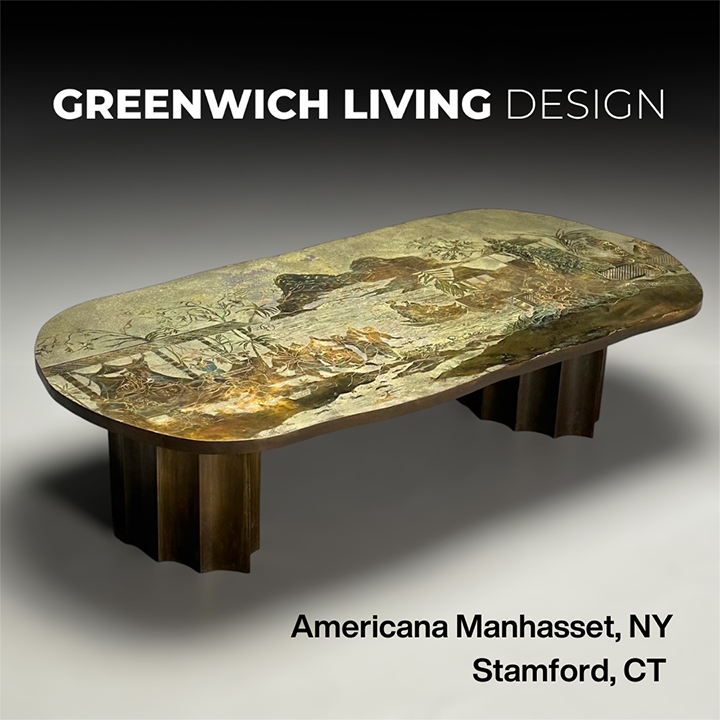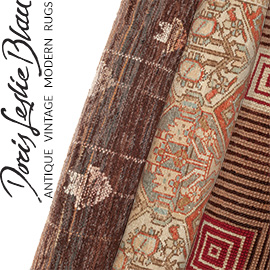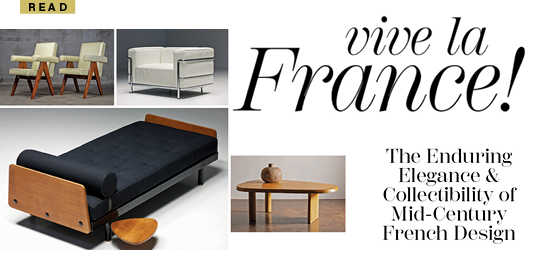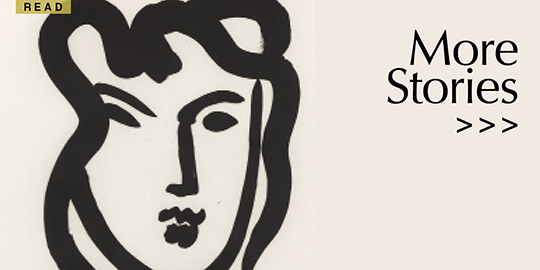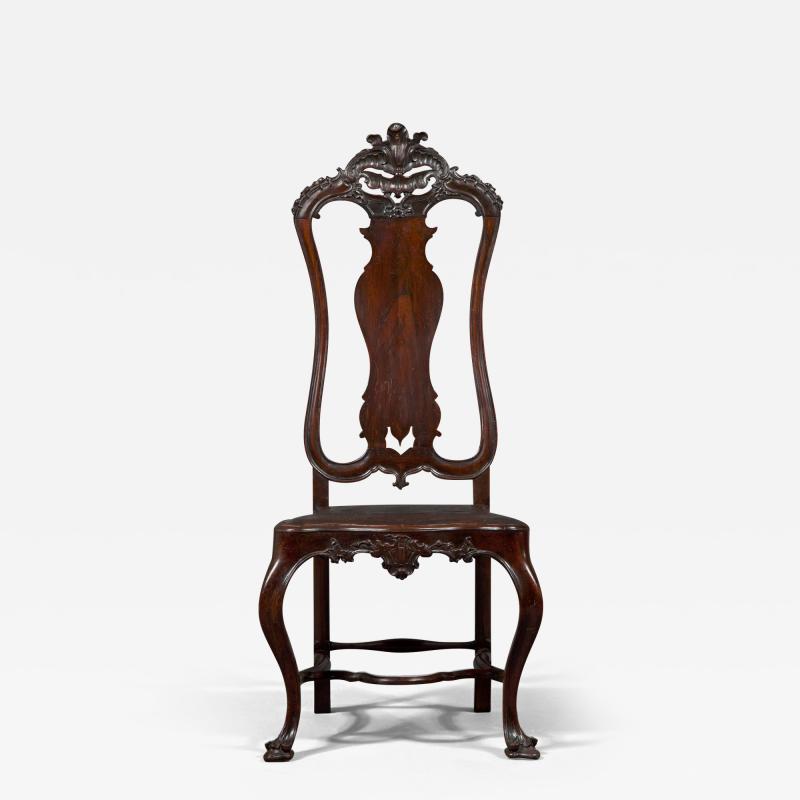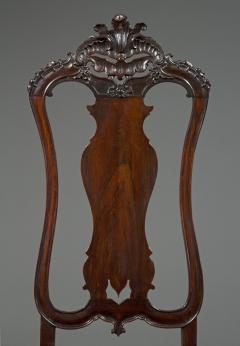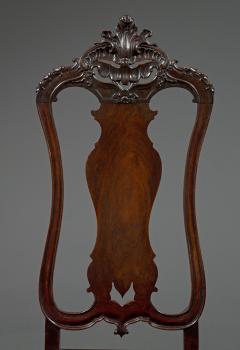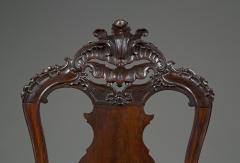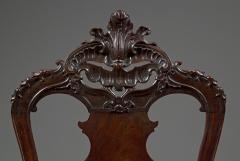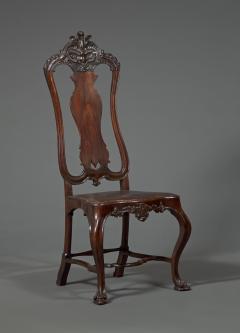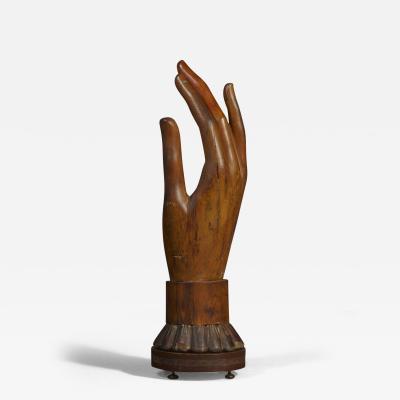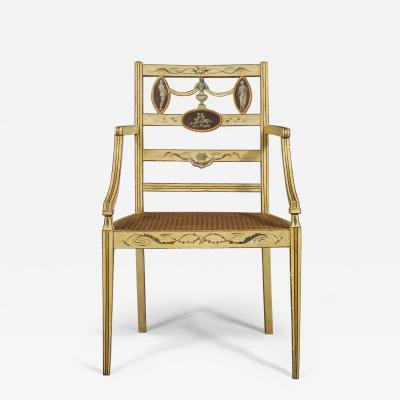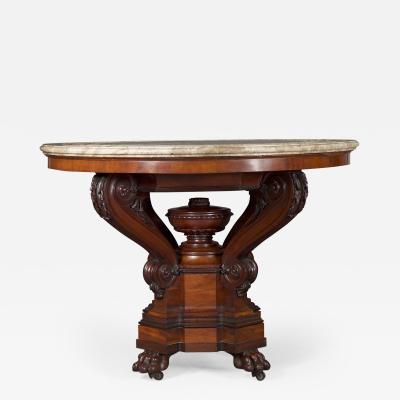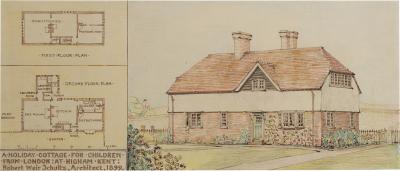Listings / Furniture / Seating / Side Chairs
AN EXTREMELY FINE PAIR OF JOSÉ I CARVED JACARANDA SIDE CHAIRS
-
Description
AN EXTREMELY FINE PAIR OF JOSÉ I CARVED JACARANDA SIDE CHAIRS
Brazilian Or Portuguese. Circa 1755.
Measurements
Height: 52" (132cm)
Width: 23" (58.5cm)
Depth: 21 1/2" (54.5cm)
Research
Of jacaranda. Each with a shaped pierced back surmounted by a carved rocaille scroll above a shaped splat, the original embossed leather seat depicting a cupid, the seat above the shaped and carved apron, the whole raised on four legs, the front pair of cabriole form terminating in hooved feet, the outswept rear legs, the legs united by a shaped stretcher.
Marks:
Bears label:
Butler Capital Corporation
Art & Antique Collection
35 Cadogan Square London SW 1
Description: A rare and fine pair of high back chairs. Portuguesse, period of King D Jose I (1750-1777)
Category: Antique Furniture
Purchased from: Spink & Son Ltd.
Acquisition Date: 11/02/89 Inventory: #AF-26
Provenance:
Spink & Son Ltd.
From whom acquired by Butler Capital Corporation, Cadogan Square, London, November 2, 1989.
This pair of jacaranda side chairs is an example of fashionable Anglophile taste in eighteenth century colonial Latin America by way of Portugal, the influence of which lasted from the 1690’s through to the development of neoclassicism in the 1780s. Elements of the chairs’ design can be found in the work of Thomas Chippendale, as published in the three editions of his Gentleman and Cabinet Maker’s Director from 1754.
Portugal and England shared a significant bond during the eighteenth century, brought about by Portugal’s decision in 1703 to fight along side the British in the War of Spanish Succession and its bitter relations with the other leading European nations. A vogue for furniture in the English style thus developed, seeded by the many pieces brought back to Portugal in 1693 by the widowed Catherine of Braganza, Queen Consort of Charles II of England and daughter of John IV of Portugal. Figure 1 depicts a Portuguese side chair, circa 1750-1775, with a similar shape and carving of the backrest and wrought leather seat. As a colony of Portugal, Brazil was exposed to the English taste initially through these British imports and Portuguese variants, and, subsequently, original pieces by Brazilian craftsman were executed in this style.
While English prototypes inspired the chairs, their Brazilian origin is revealed in the use of jacaranda wood, native to the tropical and sub-tropical regions of South America, particularly Brazil, although much Portuguese furniture is also sometimes fabricated in this precious timber. Additionally, the embossed seats of the chairs form part of the tradition of sumptuous Portuguese leatherwork, which extended to Brazil in the 18th century. The motifs of metropolitan Portugal were copied in colonial Brazil by leatherworkers called coreiros and included human, animal, floral, mythological, and exotic scenes.1
The scene embossed on the present chairs is composed of a border of diaperwork and floral decoration surrounding an elaborate rocaille motif. Within the design a blindfolded cupid points his arrow at a winged and flaming heart with an eye at its center, possibly representing the Eye of Providence. The flaming heart signifies extreme ardour or religious fervor, and is an attribute of St. Anthony of Padua (also known as Anthony of Lisbon), patron saint of Brazil, who is known there as the marriage saint.
It is not always possible to differentiate with certainty whether an item of furniture was made in Portugal or Brazil. However, a rule of thumb indicates that the greater the quality, the more likely it is that manufacture took place in the colony, as the superior carving skills were developed there. -
More Information
Period: 18th Century Condition: Good. Styles / Movements: Traditional Dealer Reference #: 9138 Incollect Reference #: 753996 -
Dimensions
W. 23 in; H. 52 in; D. 21.5 in; W. 58.42 cm; H. 132.08 cm; D. 54.61 cm;
Message from Seller:
Carlton Hobbs specializes in the acquisition, conservation, and research of 17th, 18th and 19th century British and Continental furniture and works of art, with a focus on pieces of exceptional merit, including specially commissioned items with royal or aristocratic provenance and pieces designed by architects.




